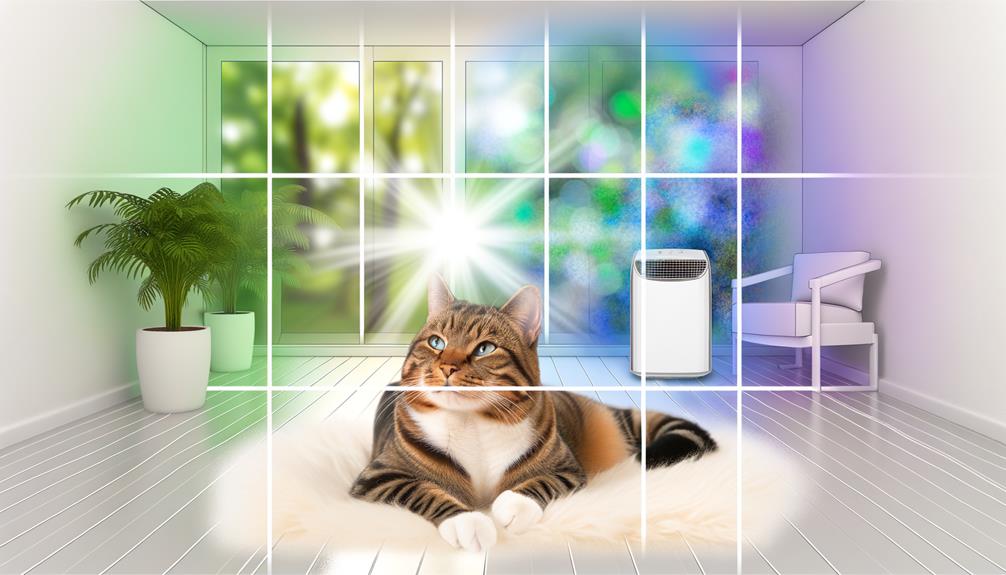When you suspect your cat has been exposed to mold, the first step is to remove them from the contaminated environment and seek veterinary help immediately. You'll need to keep an eye on symptoms like coughing, sneezing, or unusual lethargy, and relay this information to the vet along with details about the exposure. Treatment can range from medications to more intensive care depending on the severity. But what's most essential after initial treatment? Ensuring your home remains mold-free to prevent future issues, and there's a lot more to take into account in that regard.
Recognizing Mold Exposure Symptoms
Recognizing mold exposure symptoms in cats is vital for ensuring timely and effective treatment. Mold exposure can manifest through various physical and behavioral indicators that necessitate close observation. Cats exposed to mold often exhibit respiratory symptoms such as coughing, sneezing, or wheezing. These signs suggest that mold spores have infiltrated the respiratory tract, causing irritation and potential inflammation.
You might also notice your cat displaying excessive scratching and licking behaviors. These actions are typically responses to skin irritation or allergic reactions induced by mold. Additionally, physical symptoms like runny noses or eyes, combined with nasal discharge, are common indicators of mold exposure. Such symptoms can signify underlying respiratory distress that requires prompt attention.
Behavioral changes are another significant aspect to monitor. Cats affected by mold exposure may show increased agitation or reluctance to engage in routine activities. These behavioral shifts often stem from discomfort or distress caused by the mold. Excessive sleeping, hiding behavior, and a decreased appetite are further symptoms that could indicate substantial health issues related to mold exposure.
In more severe cases, mold exposure can lead to neurological symptoms. These could include disorientation or other abnormal behaviors that signal an urgent need for veterinary care. It's important to recognize these symptoms early on to prevent the condition from escalating.
Veterinary care is indispensable once you identify these symptoms. A veterinarian can provide a thorough assessment, diagnosing the extent of mold exposure and its impact on your cat's health. Early detection and intervention are key to mitigating the adverse effects of mold exposure and ensuring your cat's well-being.
Immediate Steps to Take
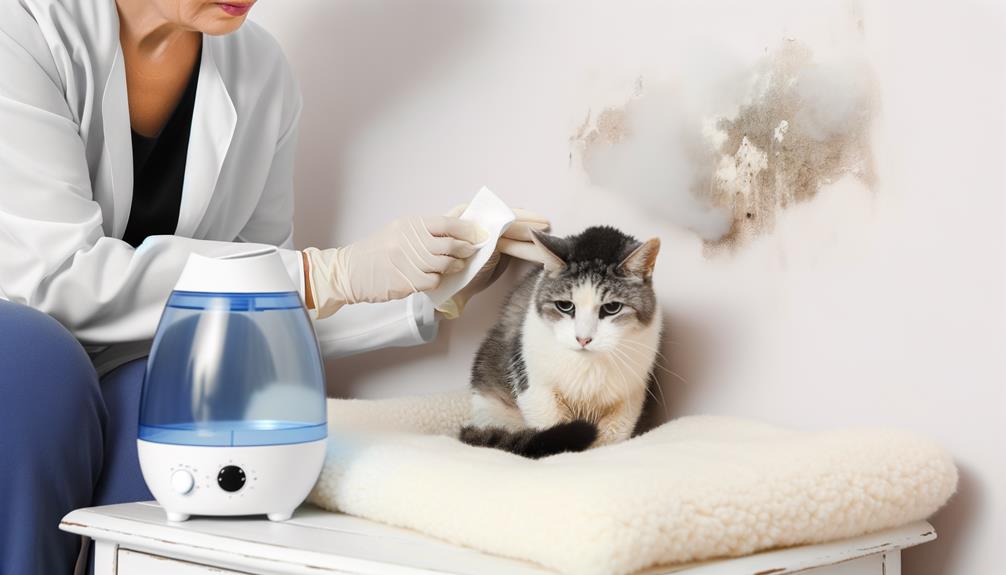
If you suspect mold exposure, immediately remove your cat from the contaminated environment to prevent further inhalation or ingestion of spores. Promptly consult a veterinarian for an assessment and treatment options, as early intervention is essential for effective recovery. Monitor your cat for symptoms such as coughing, sneezing, vomiting, or lethargy, and report these signs to your vet for appropriate care.
Assessing Symptoms Immediately
When your cat exhibits signs of mold exposure, such as coughing, sneezing, or excessive scratching, it's imperative to evaluate their symptoms immediately to gauge the severity of their condition. Start by closely monitoring for any respiratory distress. Difficulty breathing, wheezing, or persistent coughing can be vital indicators that necessitate immediate medical attention.
Additionally, observe for gastrointestinal issues like vomiting or diarrhea, which may suggest a more severe reaction to mold toxins. These symptoms can rapidly dehydrate your cat, complicating their overall health status. Changes in behavior, such as increased lethargy or hiding, may also signal discomfort or illness related to mold exposure.
It's essential to document all observed symptoms and any potential sources of mold exposure in your home. This information will be invaluable for the vet's evaluation and treatment plan. Keep a detailed log that includes the onset, frequency, and duration of each symptom. Quick and accurate evaluation of your cat's condition can greatly impact the effectiveness of the subsequent veterinary care. If you notice any alarming signs like severe respiratory distress or persistent gastrointestinal issues, don't hesitate to seek medical attention right away. Evaluating symptoms promptly can be life-saving.
Seeking Veterinary Assistance
Acting swiftly to seek veterinary assistance when you suspect mold exposure in your cat is necessary for mitigating potential health complications. Mold exposure can lead to severe issues, including respiratory distress and systemic infections, requiring prompt professional intervention.
Upon arrival at the veterinary clinic, provide a detailed account of your cat's symptoms, duration of exposure, and any known mold sources within your home. This thorough history will assist the veterinarian in formulating an effective diagnostic and treatment plan. Expect the veterinarian to perform a complete physical examination and recommend diagnostic tests, such as blood work, to evaluate your cat's overall health and identify any mold-related complications.
Treatment for mold exposure may vary depending on the severity of your cat's condition and specific symptoms. Common therapeutic approaches include antihistamines to address mold allergies, corticosteroids to reduce inflammation, and antifungal medications to combat potential infections. Adhering to the prescribed treatment regimen is essential for your cat's recovery.
Regular follow-up appointments are important to monitor your cat's progress and make necessary adjustments to the treatment plan. Maintaining ongoing communication with your veterinarian guarantees that any emerging issues are promptly addressed, optimizing your cat's health and well-being.
Veterinary Diagnosis Methods
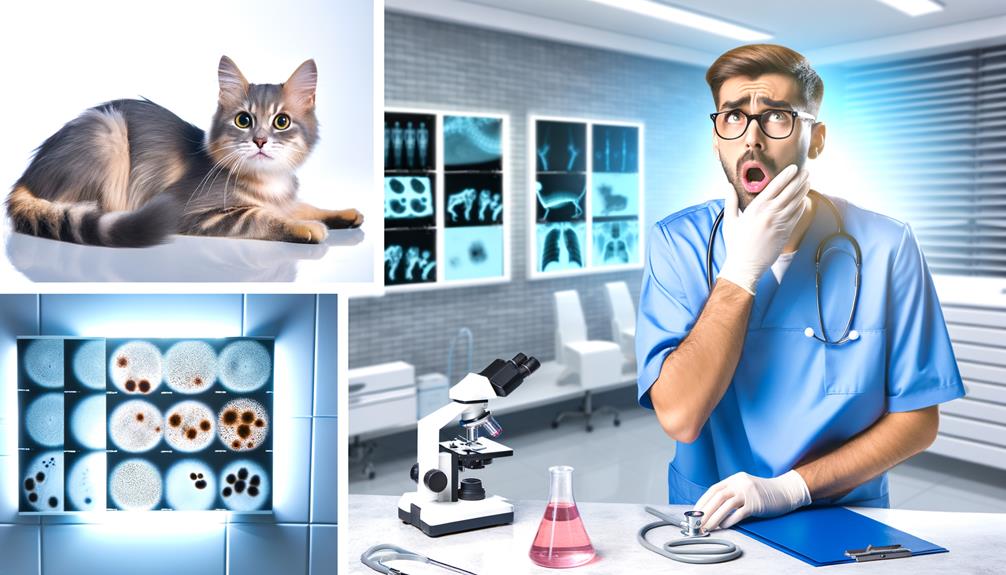
Understanding the veterinary diagnosis methods for mold exposure in cats is important for timely and effective treatment. A thorough veterinary diagnosis begins with a careful review of your cat's medical history, including the timeline of symptoms and any potential exposure to moldy environments. This step is essential for identifying possible sources and understanding the onset of clinical signs.
The physical examination of your cat may encompass various diagnostic imaging techniques such as X-rays, CT scans, or MRIs. These imaging modalities are indispensable for evaluating lung patterns and determining the extent of organ involvement caused by mold exposure. Diagnostic imaging can reveal abnormalities that aren't readily apparent during a routine physical exam.
Blood tests play a significant role in the diagnostic process. They can detect the presence of fungal antigens or antibodies, providing valuable insights into your cat's immune response to mold exposure. Blood tests help in confirming an immune reaction to fungal elements, which is instrumental in diagnosing mold-related illnesses.
Moreover, the analysis of samples from blood, tissue, urine, feces, and mucus is important for identifying specific fungi associated with mold exposure. These samples are scrutinized to detect fungal elements that might be causing the clinical symptoms in your cat.
Fungal cultures are another key component of the diagnostic process. Culturing samples from skin lesions or respiratory secretions can isolate and identify the particular mold species affecting your cat. This precise identification is crucial for formulating an effective treatment plan and ensuring the well-being of your feline companion.
Treatment Options
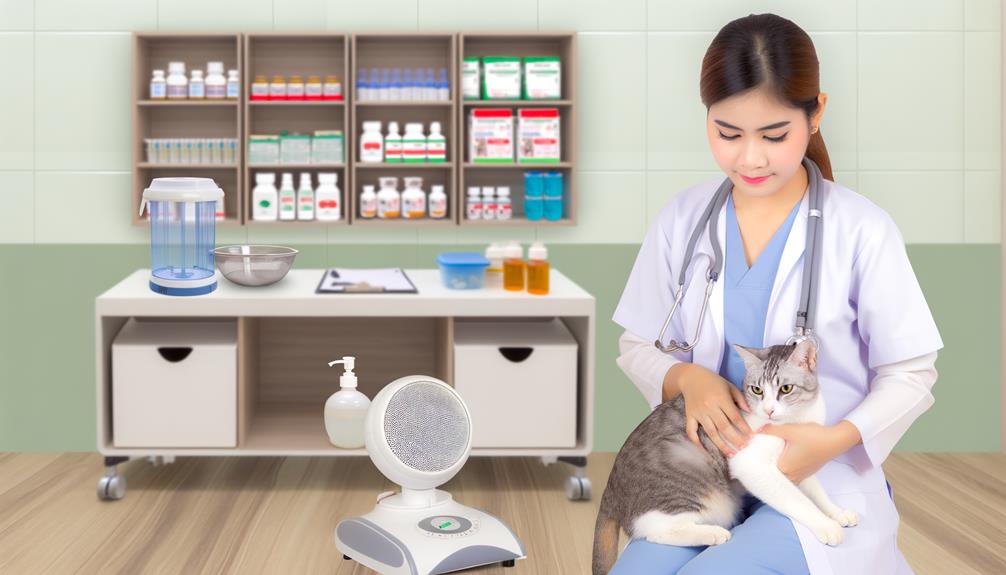
Addressing mold exposure in cats requires a multifaceted approach tailored to the specific type of mold and the severity of the symptoms. One of the primary treatment options involves administering oral antifungal medications. These medications are specifically chosen based on the type of mold involved, guaranteeing a targeted intervention that effectively combats the fungal infection within your cat's system.
For cats exhibiting allergic reactions to mold, antihistamines may be prescribed. These medications help alleviate symptoms such as itching, sneezing, and nasal discharge, thereby improving your cat's comfort and quality of life. In cases where mold exposure has led to severe respiratory distress or dehydration—often a consequence of persistent vomiting—intravenous (IV) fluids are administered. This intervention stabilizes the cat's condition and provides essential nutrients and hydration.
Secondary skin infections, which can result from excessive scratching or grooming due to mold allergies, may necessitate topical treatments or antibiotics. These additional treatments address localized infections and prevent further complications, promoting overall skin health.
Regular veterinary follow-ups are critical throughout the treatment process. Continuous monitoring allows for the assessment of your cat's recovery progress and the adjustment of treatment plans based on their response to therapy. Regular check-ups guarantee that any recurring symptoms are promptly addressed, thereby optimizing the efficacy of the treatment regimen.
Home Environment Management
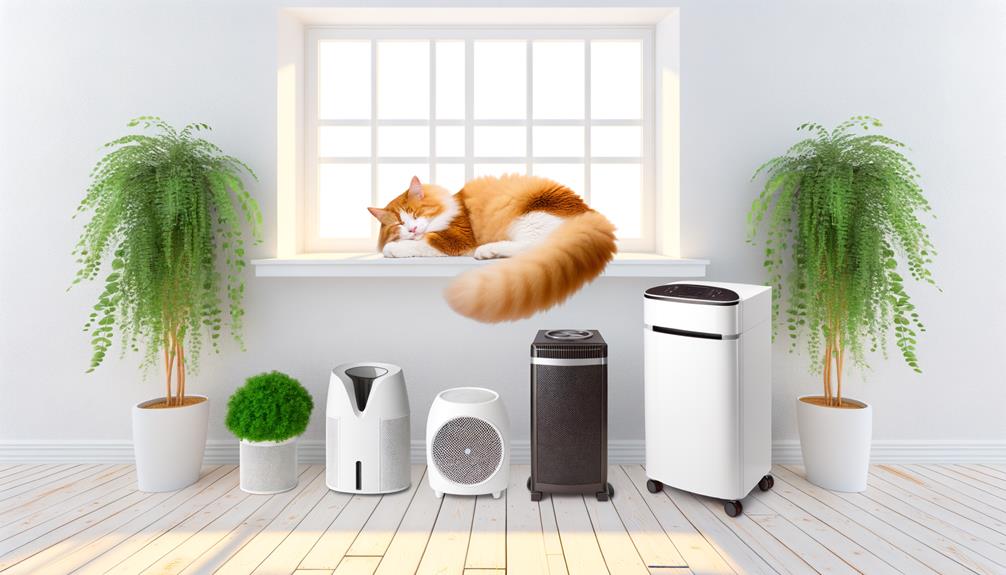
To mitigate mold exposure risks for your cat, implement stringent regular cleaning practices in moisture-prone areas such as bathrooms, kitchens, and basements. Utilize dehumidifiers to maintain indoor humidity levels below 50%, thereby reducing the likelihood of mold proliferation. Additionally, guarantee proper ventilation in spaces like laundry rooms and attics to promote airflow and lower humidity levels.
Regular Cleaning Practices
Maintaining a clean home environment is essential for minimizing mold exposure and safeguarding your cat's health. Implementing regular cleaning practices is vital to prevent mold growth and reduce the risk of cat symptoms associated with mold exposure. Regularly vacuum and dust your home, focusing on areas prone to moisture like bathrooms, kitchens, and basements, as well as places where your cat frequently resides. This helps eliminate mold spores that can trigger health issues.
Additionally, it's important to keep your cat's bedding, toys, and any fabric items in their environment clean by laundering them weekly in hot water. This practice helps eradicate any potential mold growth. Inspect and clean air ducts and HVAC systems regularly to prevent mold spores from circulating through your home.
Here's a quick reference table for effective cleaning practices:
| Task | Frequency | Focus Areas |
|---|---|---|
| Vacuum and dust | Weekly | Moisture-prone areas, cat's space |
| Launder cat's items | Weekly | Bedding, toys, fabric items |
| Clean air ducts and HVAC | Quarterly | Whole house |
| Store pet food in airtight containers | Ongoing | Feeding area |
Moisture Control Strategies
Your home's moisture control is vital in preventing mold growth and safeguarding your cat's health. Implementing effective moisture control strategies starts with maintaining indoor humidity levels below 50%. Utilize dehumidifiers, particularly in moisture-prone areas like basements and bathrooms, to inhibit mold growth. Regularly inspect and repair leaks in plumbing and roofs, as water accumulation creates ideal conditions for mold proliferation.
Enhance ventilation in kitchens and bathrooms by using exhaust fans or opening windows; this reduces humidity and moisture buildup. Additionally, employing mold-resistant materials such as mold-resistant paint and drywall during home renovations can greatly minimize the likelihood of mold development.
Routine cleaning and maintenance are essential in preventing mold spores from settling. Wash pet bedding and toys in hot water and verify they are thoroughly dried. This practice is imperative in maintaining an environment that doesn't foster mold growth.
Through diligent application of these moisture control strategies, you can effectively manage humidity levels and prevent mold from taking hold in your home. These steps not only protect your living environment but also play a significant role in protecting your cat from mold exposure.
Preventive Measures
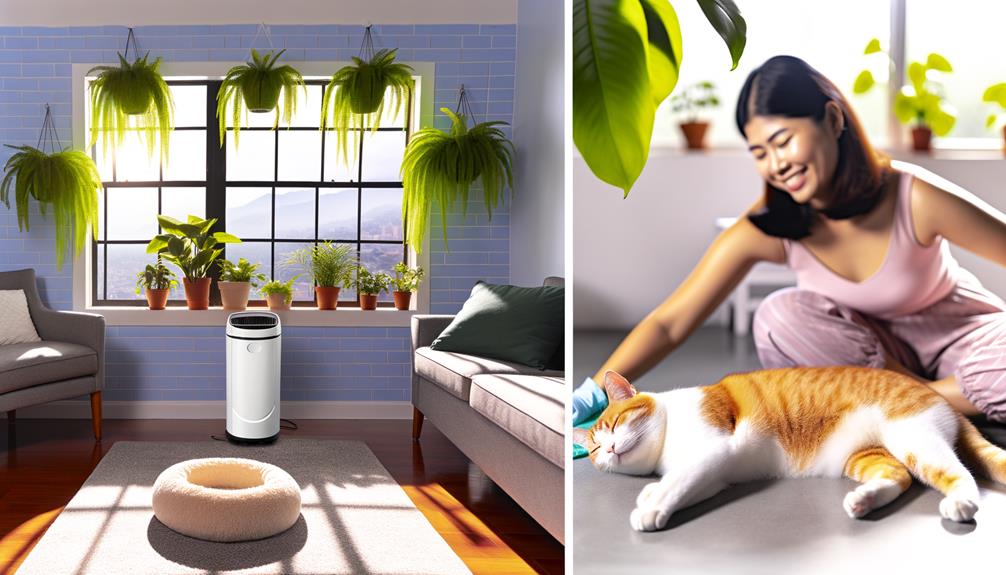
Proactive measures are vital in mitigating mold exposure risks for your cat. Implementing preventive measures can greatly enhance pet health and reduce the incidence of common pet health conditions related to mold exposure. Regularly clean and vacuum your home, particularly in areas prone to dampness and mold growth, such as bathrooms and basements. This practice is essential for reducing mold spores in the environment that your cat may inhale or come into contact with.
Maintaining ideal humidity levels in your home is another important step. Utilize a dehumidifier in high-humidity areas to keep indoor moisture below 50%. By doing so, you create an environment less conducive to mold development. Additionally, storing pet food in airtight containers can prevent mold growth; always check for signs of spoilage before feeding your cat.
Frequent washing and thorough drying of your cat's bedding, toys, and any fabrics they use can further minimize their exposure to potential mold spores. This regular maintenance guarantees that these items remain free of mold, contributing to a safer living environment for your feline companion.
Conducting regular inspections of your home for mold, especially after any water damage incidents, is imperative. Address any leaks or moisture issues promptly to prevent mold from establishing a foothold. By integrating these practices into your routine, you can greatly diminish the risk of mold exposure and its associated health complications in cats.
These preventive measures, when systematically implemented, will help safeguard your pet's health and contribute to a cleaner, mold-free living space.
